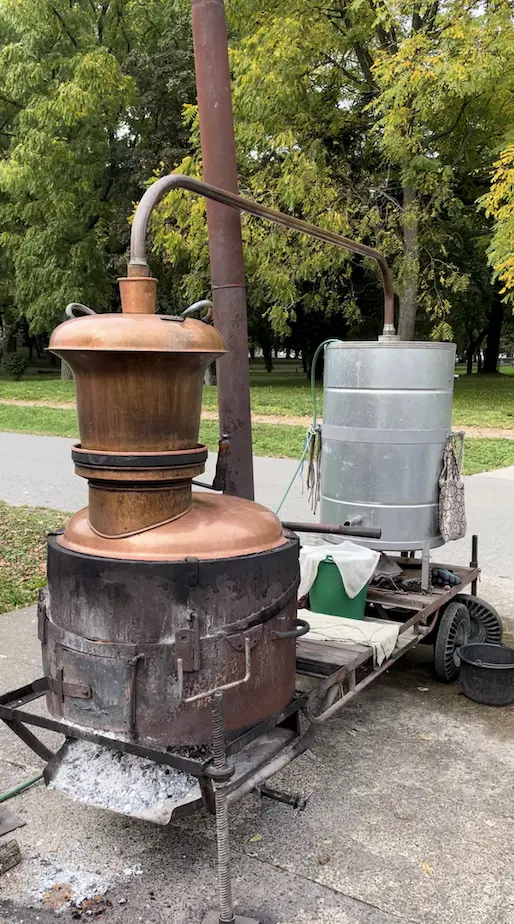Rakija Is Heavenly Brandy Popular in Eastern Europe

How to pronounce Rakija? Rah – kee – ya.
This article is your ultimate guide for Rakija (Rakia). The moment you realize that you have read the complete guide you’ll feel more confident to talk about this iconic liquor. Let’s dive deeper.
What is Rakija?
eng. brandy /ˈbrændi/
Clear and strong spirit with a very rich bouquet made from fermented and distilled fruit.
Rakija is stronger than vodka?
The percentage of alcohol in Rakija usually ranges between 40 % and 65 %. Homemade Rakija could be even stronger than a commercial one. This iconic beverage is often compared to vodka and is most popular in Eastern Europe (Balkan countries).
Distillers mostly make Rakija from plum (known as sljivovica) but it could be made virtually from any fruit such as grapes, pear, nuts, carob, fig, peach, apricot, cherry but also may be produced with herbs, mistletoe, honey.
Rakija is known as a national drink among Slavic people and Balkan countries. Poland, Bulgaria, Serbia, Croatia, Bosnia and Herzegovina, Slovakia, Romania, North Macedonia, and Turkey are countries where Rakija is a trendy alcoholic beverage. They say Rakija heals all wounds.
In Hungary, they produce Pálinka while Italy has Grappa. Germans named this liquor Schnapps which refers to snap or quickly taken.
No doubt for the French – Rakija is l’eau de vie.
In Croatia, there are two more variations: Prepecenica, which is distilled twice, and Brlja, which is a slang word used for cheap Rakija that tastes awful and is of poor quality. It is inevitable in Balkan countries to not be offered a shot of Rakija when stepping into someone’s house.
How to drink Rakija?
This heavenly drink has some simple rules to follow. Let’s be clear, do not refuse a shot of Rakija from your host if you don’t have a good reason.
One shot of Rakija is enough while two shots aren’t.
Yes, this statement is correct. But, it is super important to remember that you don’t have to prove anything to anyone and rush with your drinking. So, take it easy, and enjoy Rakija’s bouquet and its rich taste.
Recommended is to serve Rakija as an apéritif in a Rakija Glass. The biggest truth is that every household in Croatia has at least one bottle of it. In Croatia, it is common to serve some cheese and smoked ham (known as meza) as well as small appetizers. No. 1 unwritten rule of drinking Rakija is making eye contact right before you take your first sip. If you miss making eye contact then better be saying that you didn’t know.
Whether you are right about having lunch or you are having stomach pain or you accidentally cut your skin, either way, you have to take a sip or spill a bit on a hurt spot. Rakija took the status of a highly exclusive beverage thanks to a long tradition. However, it’s an inexpensive spirit with an average price from 5 € to 15 €.
How to make Rakija?

Rakija recipes may vary and the reason is a base that is used in the process. Let’s start with the most famous one.
Sljivovica (Sljiva)
This is the most common liquor in Croatian households. Sljiva is made from plum and it is distilled only once. Traditionally Sljiva’s distillation starts every year in autumn. Requirements are wood, plums, fire, water, and a container in which fermented plums boil. Bistrica is the most used sort of plum for the process.
Before you start, plums mixed with yeast should stay in wooden or plastic containers closed for three weeks. Fermentation is over when there is 0 % sugar and you can smell alcohol. If you find mold on the surface remove it.
Two-thirds of your boiler should be filled with plums for security reasons. The distillation process has to be slow-paced and lasts two or three hours. In the beginning, intensify your fire for 10 minutes not longer. When your plums are heated, condensation rises. This alcoholic gas is redirected into the cooling cylinder where it converts to Rakija.
When the first thin stream starts to trickle down that’s called prvenac. The second stream is real Sljivovica, a high-quality Rakija. The third stream and the last one are called Patoka which is of poor quality.
Obtained plum Rakija should age from 8 to 10 weeks.
Lozovaca (Loza)
The distillation process is similar to Sljiva except for the base this time you are using grapes. These grapes are separated from those that go into the wine.
When grapes are selected the next step is grape stomping. Traditionally female family members are in charge of this task. From 100 kg of fermented grapes, it is possible to produce 20 liters of Rakija with around 40 % vol. alc.
Komovica (Tropica)
Everything that’s left in the process of winemaking, grape peels, pulp, and seeds are the base for this Rakija. So you are guessing, this alcoholic beverage is of lower quality. What’s left in the process is called trop, kom, and komina (eng. pomace).
Finally, after distillation is over your Komovica Rakija is produced.
Travarica (Trava)
When it comes to this liquor from herbs, your ingredients could be both dry or fresh, isn’t that great? So there are so many variations of Travarica and you can choose ingredients on your preferences. Lozovaca is most commonly used as a base and the reason is the neutral body of Loza liquor. The process starts with filling up your bottle with neutral alcoholic liquor such as Loza, and then you put some herbs inside.
Various herbs could be used, for example, sage, rosemary, mint, pelin, lemon leaves, bay leaves, juniper berries, etc.
The next step is to put your bottle in a dark place and let it age for four weeks. Finally, you should strain your infused Travarica in new bottles.
Medica (Medovaca)
Well, Medica is a liqueur. Why? The answer is simple, this brandy contains between 15 % and 25 % vol. alc., and that isn’t enough to be classified as Rakija. Medica could be served as an apéritif or digestif.
Medica has a light yellow color, though it could be even dark brown. The Colour range depends on the type of honey used in the process. The base is fruit brandy (Rakija) such as Loza or Komovica that should be poured into the jar.
One liter of Rakija, 500 grams of honey, and up to half a liter of water. Then you should heat your mixture until the honey is melted. The amount of added water depends on you. Obtained liqueur should age for two weeks and be strained after that.
Orahovac (Orah)
This is a Walnut liqueur, that’s right. Orahovac has dark brown color and rich flavor. This lovely liqueur is made with green walnuts steeped in Rakija (Loza) for 30 days or more. You got a few more options to infuse with, e.g. vanilla, lemon peels, coffee beans, and sugar. The amount depends on your own.
Visnjevac (Visnja)
A pleasantly sweet Cherry liqueur produced from visnja (cherries). Simply put some cherries in a big jar filled with Rakija (Loza), and add some sugar. The result is one of the finest liqueurs you have ever tasted. Usually, it is served as a digestif after lunch.
Biska (Imela)
Biska Rakija is produced from the stem and leaf of mistletoe. The process is the same, cleaned ingredients of mistletoe are put inside the jar filled with Rakija (Loza). Note: mistletoe’s fruit is poisonous while leaves and stems aren’t. There is believing that Biska served as a cure against epilepsy a long time ago. The color of Rakija is greenish and the leaves should be dry before steeping. How many leaves? Well, let’s say a glass of 0,2 dl per 1 liter.
If you travel to some of the countries of Eastern Europe, try to find some authentic spots where you can drink a homemade Rakija!

